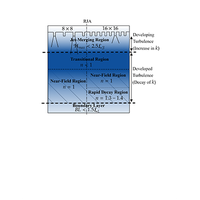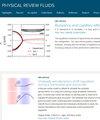使用随机射流阵列的湍流演变
IF 2.5
3区 物理与天体物理
Q2 PHYSICS, FLUIDS & PLASMAS
引用次数: 0
摘要
随机射流阵列(RJAs)已被证明可以有效地产生零平均流均质各向同性湍流。虽然许多实验室研究已经对这些设施中的流动进行了调查,但关于湍流的演变,从湍流的发展到湍流的衰减,以及了解射流阵列的输入能量如何转移到不同的湍流特性等,还存在一些问题。为了解决这些问题,我们进行了一系列实验室实验,在实验中我们改变了随机算法的参数以及射流间距和射流出口速度。我们首先确定了湍流过渡到充分发展状态的位置,并证明它是射流穿透长度 LJ 和有效射流间距 Se 的函数。我们确定了 RJA 设备中湍流空间衰减的三个不同区域,值得注意的是,我们发现了不同的衰减速率,这与之前使用类似设备只报告一种空间衰减速率的研究不同。研究表明,这些区域取决于输入参数的变化,但与平均流的强度无关。我们还发现,平均流的强度不会影响均质性,也不会影响湍流动能预算方程中的生成、传输或平流项。最后,我们解决了一个长期存在的问题,即根据输入参数用 RJA 估算湍流度量。我们定义了一个效率参数,该参数可帮助我们了解输入功率向所产生湍流的耗散率的转移率。本文章由计算机程序翻译,如有差异,请以英文原文为准。

Evolution of turbulence using a random jet array
Random jet arrays (RJAs) have been shown to be effective in generating zero mean flow homogeneous isotropic turbulence. While many laboratory studies have investigated the flow in these facilities, there are several remaining questions regarding the evolution of turbulence, from the development of turbulence to where it decays, along with understanding how input energy from the jet array transfers into different turbulent flow characteristics. To address these questions, we perform a series of laboratory experiments in which we alter the parameters of the randomized algorithm, along with the jet spacing and outlet velocity of the jets. We first determine the location where turbulence transitions to a fully developed state and show that it is a function of jet penetration length, , and effective jet spacing, . We identify three distinct regions for the spatial decay of turbulence in RJA facilities and notably, we find different decay rates, unlike previous studies that report only one spatial decay rate using similar facilities. These regions are shown to depend on the variations of input parameters yet independent of the strength of the mean flow. We also find the strength of the mean flow does not affect the homogeneity, nor the production, transport, or advection terms of the turbulent kinetic energy budget equation. Finally, we address a longstanding question toward estimating turbulence metrics with an RJA based on the input parameters. We define an efficiency parameter that provides insight into the transfer rate of input power to the dissipation rate of the generated turbulence.
求助全文
通过发布文献求助,成功后即可免费获取论文全文。
去求助
来源期刊

Physical Review Fluids
Chemical Engineering-Fluid Flow and Transfer Processes
CiteScore
5.10
自引率
11.10%
发文量
488
期刊介绍:
Physical Review Fluids is APS’s newest online-only journal dedicated to publishing innovative research that will significantly advance the fundamental understanding of fluid dynamics. Physical Review Fluids expands the scope of the APS journals to include additional areas of fluid dynamics research, complements the existing Physical Review collection, and maintains the same quality and reputation that authors and subscribers expect from APS. The journal is published with the endorsement of the APS Division of Fluid Dynamics.
 求助内容:
求助内容: 应助结果提醒方式:
应助结果提醒方式:


